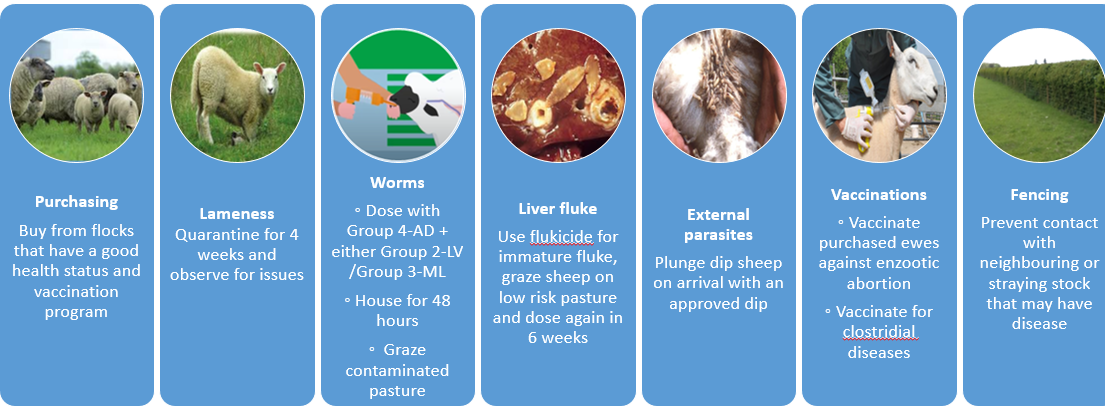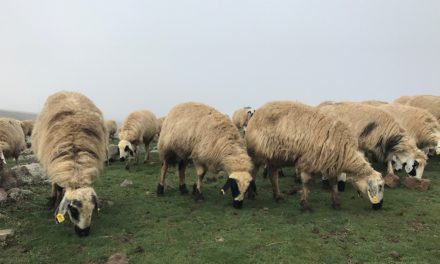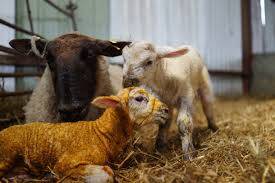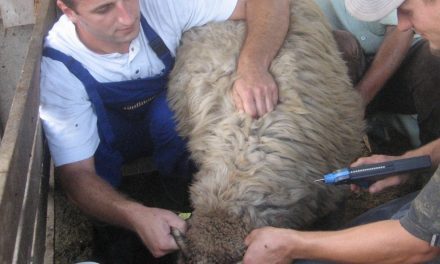This post is also available in:
![]()
![]()
![]()
![]()
![]()
![]()
Flock Biosecurity
Solution name: Flock biosecurity – develop a health plan
Aim: To present best practise guide for flock biosecurity
Description:
- Diseases (e.g. footrot, CODD, iceberg diseases, enzootic abortion) are highly infectious and can spread rapidly.
- Purchased sheep (rams, ewes) are a risk of introducing disease, parasites or anthelmintic resistance to a flock.
- A good flock biosecurity protocol is important for the overall improvement in health, welfare and productivity of animals, and will reduce the incidence of disease on farms.
How to implement:
Biosecurity protocol to be implemented in the flock health plan:
- For lameness farmers should quarantine all purchased sheep for 4 weeks and observe for any issues
- For internal parasites, purchased sheep should be
- treated with an Amino Acetonitrile Derivative (group 4-AD) + either Levamisole (Group 2-LV) or Macrocyclic Lactone (Group 3-ML)
- housed after dosing for 48 hours
- turned out to contaminated pasture (i.e. pasture recently grazed by sheep)
- Purchased sheep should be given a flukicide that targets immature fluke, grazed on dry paddocks for 6 weeks and followed up with another flukicide dose for immature fluke
- For scab, lice, keds and tick control sheep must be plunge dipped using an approved sheep dip
- Vaccinate purchased ewes against enzootic abortion and have a flock enzootic abortion vaccination programme if regularly buying in replacements
- Vaccinate purchased sheep with Clostridial and Pasteurella vaccine
- Effective boundary fences are an important factor for biosecurity to prevent contact with neighbouring or straying stock that may have disease
Topic: Health
Production: Dairy / Meat
Animal Category: Adult / Lamb / Replacement
Issue: Flock Health plan
Level of Solution: Knowledge, Practical
Country: Ireland
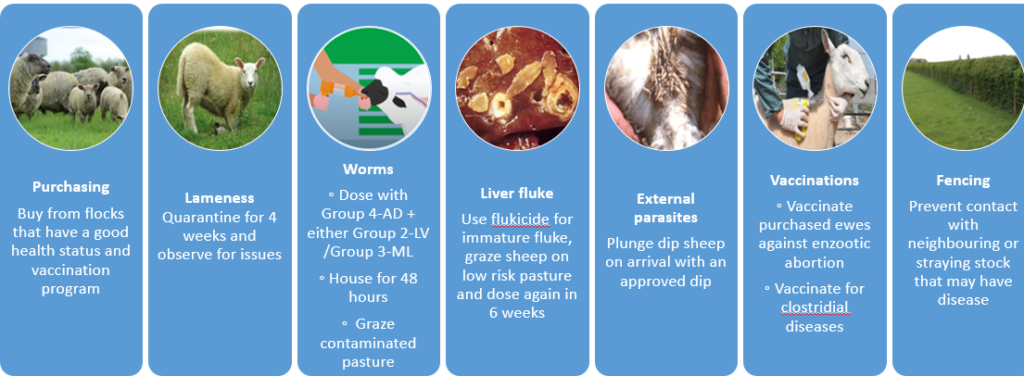
Expected benefits
Expected benefits: Reduce the introduction and spread of disease and anthelmintic resistance on farm, which negatively affects animal productivity.
Prerequisites and/or limits (knowledge, training, capabilities, cost, management, facilities, equipment, etc.)
- Purchased stock need to have an area to quarantine before being introduced to the rest of the flock (housed for 48 hours after dosing)
- Purchase rams at least 4 weeks before they are introduced to the flock
- Good farm fencing is necessary
- Commonage and hill grazing can present challenges to managing the spread of disease so good cooperation between shareholders is required and a common health plan
Cost Benefit analysis
Improving flock biosecurity reduces flock health issues and thus reduces medicine (antibiotic use), anthelminthic resistance and labour requirements. Improving flock biosecurity also increases animal performance and output, and thus profitability.
Sustainability analysis
An effective flock biosecurity protocol improves feed efficiency as the animals have an improved growth rate and are slaughtered earlier. Greenhouse gas emissions per kg of carcass is reduced due to improved animal performance. A reduction in medicine and anthelmintic use depends on the potential disease/parasites that have been avoided in the flock due to correct biosecurity protocol.
An effective biosecurity protocol improves animal welfare by avoiding health and parasite issues, this reduces physical labour, improves farm image and potentially leaves additional leisure time.
Tips & Tricks
| Tips & Tricks Links | |||||||
| Benefit expected | Increase productivity: -less mortality |
||||||
Expected Impact
| Benefit | |||||||
| Benefit expected | Increase productivity: -less mortality |
||||||
| System | |||||||
| Is the solution suitable for various production systems | Y | ||||||
| If no – for which system | dairy & meat | ||||||
| Cost | |||||||
| What are the asset costs | <100/lamb | ||||||
| What are the maintenance costs | <50/lamb | ||||||
| Any limits to its applicability | No | ||||||
| Work Load | |||||||
| Farmers | Service provider/tech.-vet-others | ||||||
| How much time is required to prepare and implement the solution | >=1week | ||||||
| How many people is needed to implement the solution? | 1 person (the farmer) | ||||||
| Timing | |||||||
| How long it takes to get results? | >=1week | ||||||
| How long it takes to see an effect on sheep productivity? | current production period | ||||||
| Equipment/Facility | |||||||
| Farmers | Service provider/technicians-vet-others | ||||||
| What kind of equipment/tool are necessary? | Lambing pens, UV bulbs, bedding materials | ||||||
| Skill/Knowledge-Training (farmer) | |||||||
| Does the solution need any specific skill/knowledge or training? | Yes | ||||||
| How much time will be required for training | 1 day training | ||||||
| Wider Environment | |||||||
| Is there any particular regulation link to the solution? | NO | ||||||
| Does the solution need any particular structure or organisation? | NO | ||||||
Users' Evaluation
| Country | TURKEY, SPAIN |
| Solution No/Name | 41. Designing proper sheds for lambing |
| Farmer/Service provider/technicians-vet-others | Farmers |
| Why did you select this solution? | To improve lamb health and increase survival rate |
| Was it easy to implement? | Yes |
| If not say what are the identified drawbacks? | – |
| Did you need to adapt it? | Yes |
| If yes, how? | It is necessary to take into account the features of the facilities (square meters of the shed, bedding type and quality, separation by lambing type) |
| Were you happy with the outcome of the solution? | Yes |
| What were the outcomes? |
98% of the ewes bonded with their lamb(s) Lower numbers of orphan lambs Less incidence of diarrhea |
| Score the solution | Interesting and easy to implement |
| Will you continue to implement it? | Yes |
| If not, for which reasons? | |
| Comments/Additions | Recommend this easy application to everyone |
Information Source / Usefull links
- Podcast https://share.transistor.fm/s/640856ee
- Treatment plan for purchased lambs (page 11) https://www.teagasc.ie/media/website/publications/2017/Teagasc-Finishing-Store-Lambs.pdf

